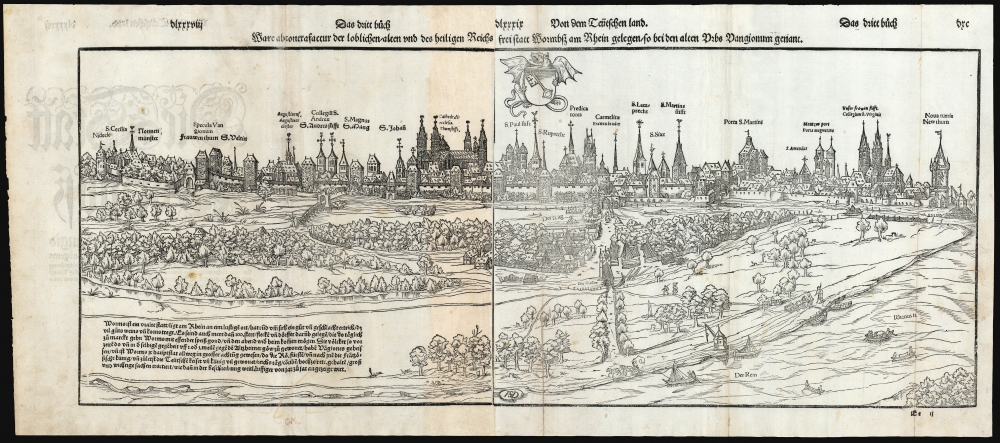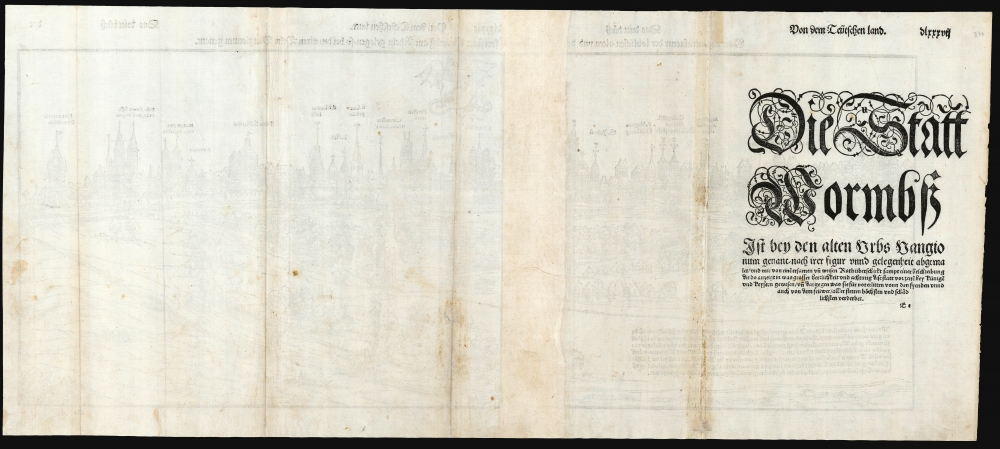1550 Münster View of Worms, Germany
Worms-munster-1550
Title
1550 (dated) 11 x 25.5 in (27.94 x 64.77 cm)
Description
A Beautiful Late Medieval City
The view is oriented to show the German city as seen from the southeast, from across the Rhine. The view, engraved to two blocks to accommodate its breadth and detail, shows a lively city on a busy river, but it is the skyline that commands the eye. The spires of more than twenty churches and cathedrals, all named, tower above the medieval city. Worms was important as an Imperial free city as well as a religious center. It was a Diocesan city - the seat of a bishop - and as such contained seminaries, monasteries, parish churches and chapels with their attendant clergy. The city was host to several important imperial diets throughout the Middle Ages, including the 1521 Diet of Worms, which resulted in Martin Luther being declared a heretic. Worms was also a significant city in printing history, having both Martin Luther's German Bible and William Tyndale's first complete English New Testament by 1526. Münster's having lavished upon Worms this full two page, fold-out panorama is an indication of the importance of this city even a quarter century after the famous Diet.Adding to the Cosmographia
From its first printings in 1544, Münster's Cosmographia was notable for the number of maps and views depicting their subjects for the first time in print, often from residents of the regions shown. In subsequent editions, Münster labored to build the work by ordering the production of improved city views and additional decorative woodcuts. 1550 saw the addition of this cut, along with many other maps and views to appear in the body of the work. Münster's spur to do so was the 1548 publication of Johannes Stumpf's magnificently illustrated history of Switzerland, whose woodcut maps and views outstripped those in Cosmographia both in quality and in number. Münster knew he had to improve, and commissioned many of the woodcuts that would make his work most popular.Publication History and Census
This woodcut was executed, between 1548 and 1550, by an anonymous formschneider known only by his initials appearing at the bottom center of the view: HSD. He produced many of the woodcuts in Münster's expanded Cosmographia. This work first appeared in the 1550 German edition, but it did not appear in every one of subsequent editions: for example, it is absent in the German 1553 edition. The present example conforms typographically to its first edition the 1550 German-text edition; it is also distinct from later printings by the absence of any of the damage to the border that we see appearing in 1556, and increasingly in 1561. Five separate examples in various editions are listed in OCLC.CartographerS
Sebastian Münster (January 20, 1488 - May 26, 1552), was a German cartographer, cosmographer, Hebrew scholar and humanist. He was born at Ingelheim near Mainz, the son of Andreas Munster. He completed his studies at the Eberhard-Karls-Universität Tübingen in 1518, after which he was appointed to the University of Basel in 1527. As Professor of Hebrew, he edited the Hebrew Bible, accompanied by a Latin translation. In 1540 he published a Latin edition of Ptolemy's Geographia, which presented the ancient cartographer's 2nd century geographical data supplemented systematically with maps of the modern world. This was followed by what can be considered his principal work, the Cosmographia. First issued in 1544, this was the earliest German description of the modern world. It would become the go-to book for any literate layperson who wished to know about anywhere that was further than a day's journey from home. In preparation for his work on Cosmographia, Münster reached out to humanists around Europe and especially within the Holy Roman Empire, enlisting colleagues to provide him with up-to-date maps and views of their countries and cities, with the result that the book contains a disproportionate number of maps providing the first modern depictions of the areas they depict. Münster, as a religious man, was not producing a travel guide. Just as his work in ancient languages was intended to provide his students with as direct a connection as possible to scriptural revelation, his object in producing Cosmographia was to provide the reader with a description of all of creation: a further means of gaining revelation. The book, unsurprisingly, proved popular and was reissued in numerous editions and languages including Latin, French, Italian, and Czech. The last German edition was published in 1628, long after Münster's death of the plague in 1552. Cosmographia was one of the most successful and popular books of the 16th century, passing through 24 editions between 1544 and 1628. This success was due in part to its fascinating woodcuts (some by Hans Holbein the Younger, Urs Graf, Hans Rudolph Manuel Deutsch, and David Kandel). Münster's work was highly influential in reviving classical geography in 16th century Europe, and providing the intellectual foundations for the production of later compilations of cartographic work, such as Ortelius' Theatrum Orbis Terrarum Münster's output includes a small format 1536 map of Europe; the 1532 Grynaeus map of the world is also attributed to him. His non-geographical output includes Dictionarium trilingue in Latin, Greek, and Hebrew, and his 1537 Hebrew Gospel of Matthew. Most of Munster's work was published by his stepson, Heinrich Petri (Henricus Petrus), and his son Sebastian Henric Petri. More by this mapmaker...
Heinrich Petri (1508 - 1579) and his son Sebastian Henric Petri (1545 – 1627) were printers based in Basel, Switzerland. Heinrich was the son of the printer Adam Petri and Anna Selber. After Adam died in 1527, Anna married the humanist and geographer Sebastian Münster - one of Adam's collaborators. Sebastian contracted his stepson, Henricus Petri (Petrus), to print editions of his wildly popular Cosmographia. Later Petri, brought his son, Sebastian Henric Petri, into the family business. Their firm was known as the Officina Henricpetrina. In addition to the Cosmographia, they also published a number of other seminal works including the 1566 second edition of Nicolaus Copernicus's De Revolutionibus Orbium Coelestium and Georg Joachim Rheticus's Narratio. Learn More...
Source
Munster's methodology in Cosmographia is notable in particular for his dedication to providing his readers with direct access to firsthand reports of his subjects wherever possible. Many of the maps were the result of his own surveys; others, the fruit of an indefatigable letter writing campaign to scholars, churchmen and princes throughout Europe, amicably badgering them for maps, views, and detailed descriptions of their lands. For lands further afield than his letters could reach, Munster relied on the best that the authorities of northern European scholarship could offer: he was well familiar with the work of Waldseemuller and other geographers of the early 16th century, and was well connected with the best geographers of his own generation. A disproportionate number of the maps of Cosmographia show contemporary geographical knowledge of the their respective areas for the very first time: The first map to show the continents of the Western Hemisphere; the first map to focus on the continent of Asia; the first modern map to name the Pacific Ocean; the first map to use a key; the first modern map of the British Isles and so on. Even in cases where earlier maps exist, Munster's works very often remain the earliest such acquirable by the collector.




